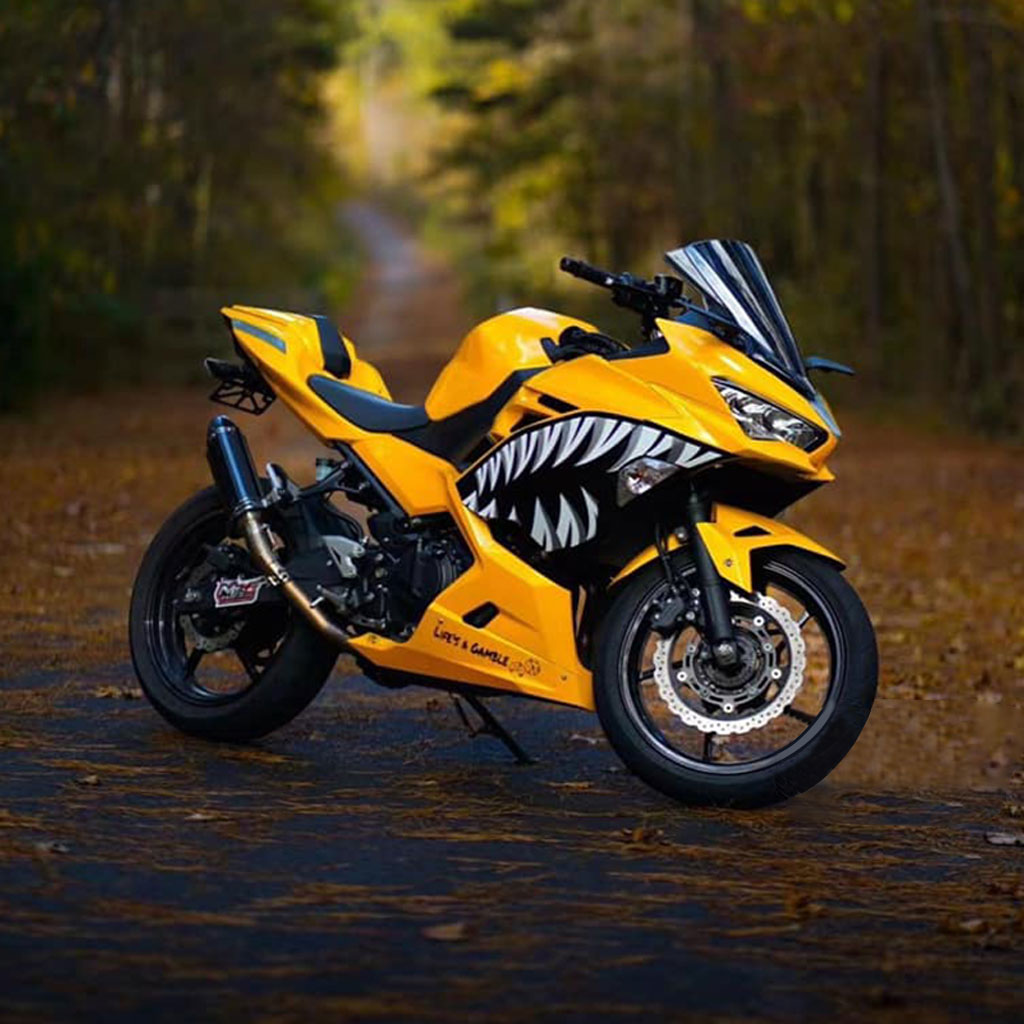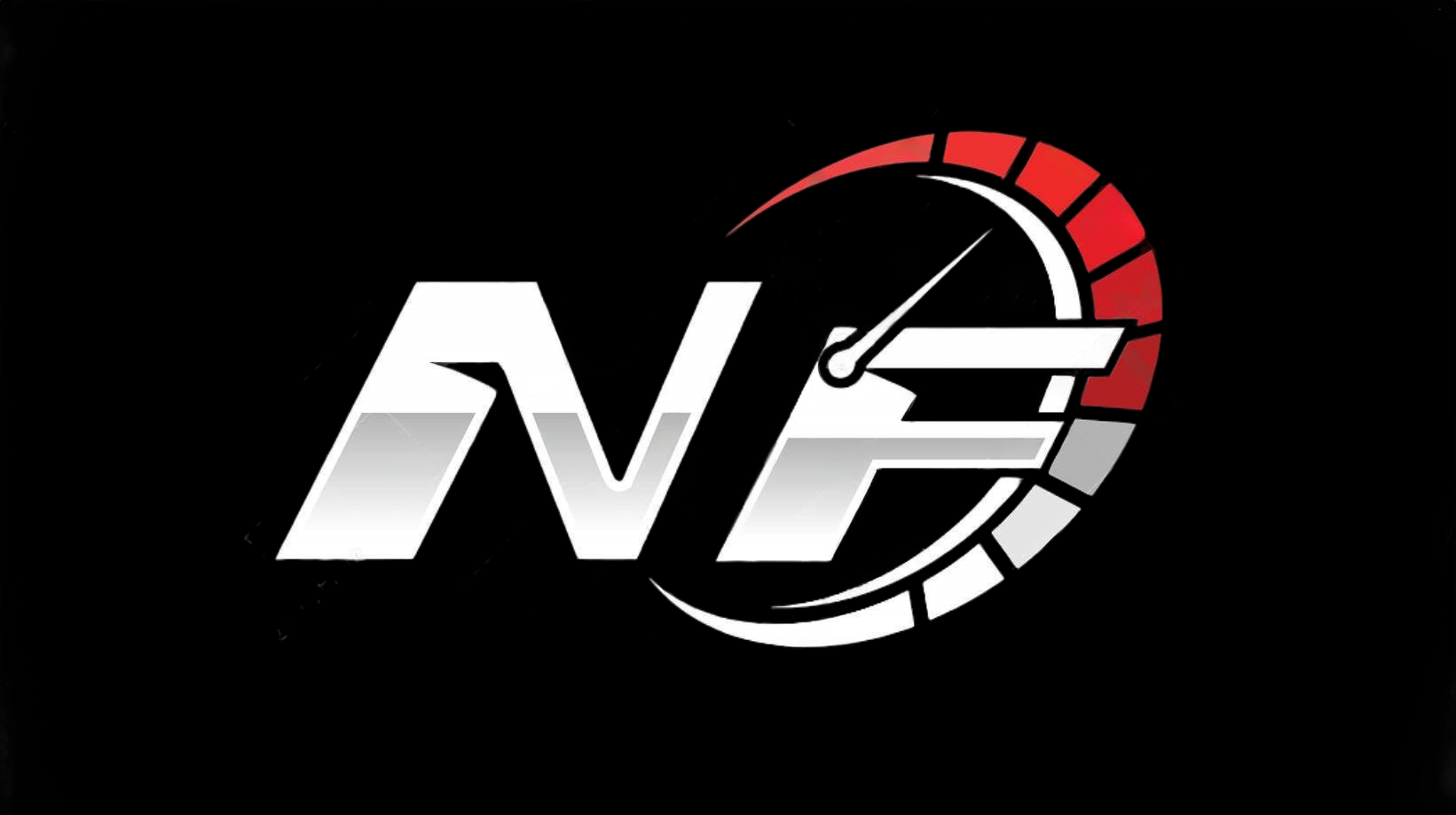A step-by-step guide to black and gold motorcycle helmet safety and style
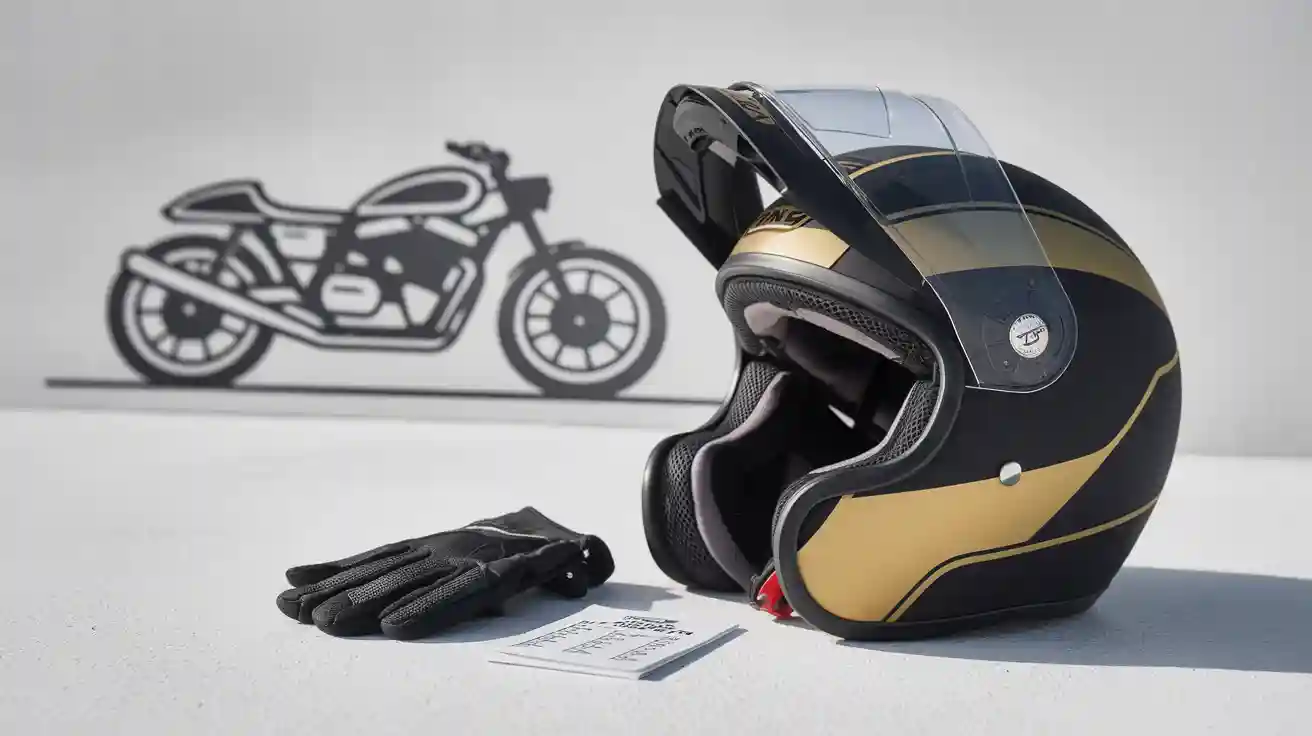
When you choose a black and gold motorcycle helmet, you do more than make a style statement. You give yourself vital protection. Certified helmets lower your risk of head injury by almost 70% and help prevent serious facial injuries. Full-face helmets offer the most protection, especially for your jaw and face. Picking the right helmet lets you show off your style while keeping you safe on every ride.
Why Black and Gold Motorcycle Helmet Selection Matters
Safety Benefits of a Quality Motorcycle Helmet
You protect your head every time you wear a helmet. A good helmet gives you the best chance to avoid serious injury in a motorcycle crash. Certified helmets, such as those with DOT or Snell approval, lower your risk of head injury by 69% and reduce the chance of dying in a crash by 37%. You should always look for a helmet that fits snugly. It should not move when you shake your head. The right fit keeps the helmet in place during an accident and helps the padding absorb impact. Full-face helmets give you the most protection. They cover your face and jaw, which are often hurt in motorcycle accidents. New helmet materials, like carbon fiber and MIPS technology, help absorb more force and protect your brain from twisting injuries. You should replace your helmet every five years or after any crash, even if you do not see damage. Other gear, such as jackets and gloves, helps, but the helmet is the most important for motorcyclists.
Tip: Always check for a secure retention system and comfortable padding. These features keep your helmet in place and make long rides safer.
Expressing Your Style with Black and Gold Helmets
You can show your personality with your helmet choice. Many motorcyclists pick a black and gold motorcycle helmet for its bold look. This color combination stands out and adds a touch of luxury to your gear. However, you should know that helmet color affects how visible you are on the road. Experts say that dark helmets, like black, blend into the road, especially at night. This makes it harder for drivers to see you and can lead to more severe injuries. Lighter colors, such as silver or grey, help other drivers notice you. While gold adds style, it may not increase visibility as much as bright colors. When you choose a helmet, balance your style with safety. Pick a design that looks good but also helps you stay visible to others. Your helmet should protect you and help you stand out on the road.
Checking Motorcycle Helmet Age and Replacement Timing
Signs Your Helmet Needs Replacing
You need to check your motorcycle helmet often to make sure it still protects you. Many riders do not notice when their helmet gets old or damaged. You should look for these signs:
- Your helmet is older than five years.
- You dropped your helmet hard or had a crash while wearing it.
- The foam liner inside feels compressed or cracked.
- The helmet does not fit snugly anymore, or the straps and buckles do not work well.
- You see cracks, dents, chips, fading, or discoloration on the outside shell.
- The chin strap looks frayed or loose.
- The comfort padding inside feels worn out or loose.
Tip: Always replace your helmet after any accident, even if you do not see damage. The inside parts may be broken and not protect you in another crash.
Understanding Motorcycle Helmet Lifespan
You may wonder how long your motorcycle helmet lasts. Most helmet manufacturers and safety groups say you should replace your helmet every five years from the date you bought it. This rule helps you stay safe because helmet materials break down over time. Sunlight, heat, and sweat can make the foam and glue inside your helmet weak. Even if you do not ride often, your helmet still ages.
- Helmets with thermoplastic shells, like polycarbonate or ABS, get brittle faster from UV rays and heat.
- Composite shells, such as fiberglass or carbon fiber, last longer but the foam liner still wears out.
- Lower-priced helmets may need replacement sooner because the padding and straps wear out in two to three years.
- Premium helmets use better materials and may feel comfortable longer, but you should still follow the five-year rule.
You should store your helmet in a cool, dry place to help it last. If you ride your motorcycle every day, check your helmet more often for signs of wear. Remember, price does not always mean better protection. Always choose a helmet that fits well and replace it on time to keep yourself safe.
Ensuring Proper Motorcycle Helmet Fit
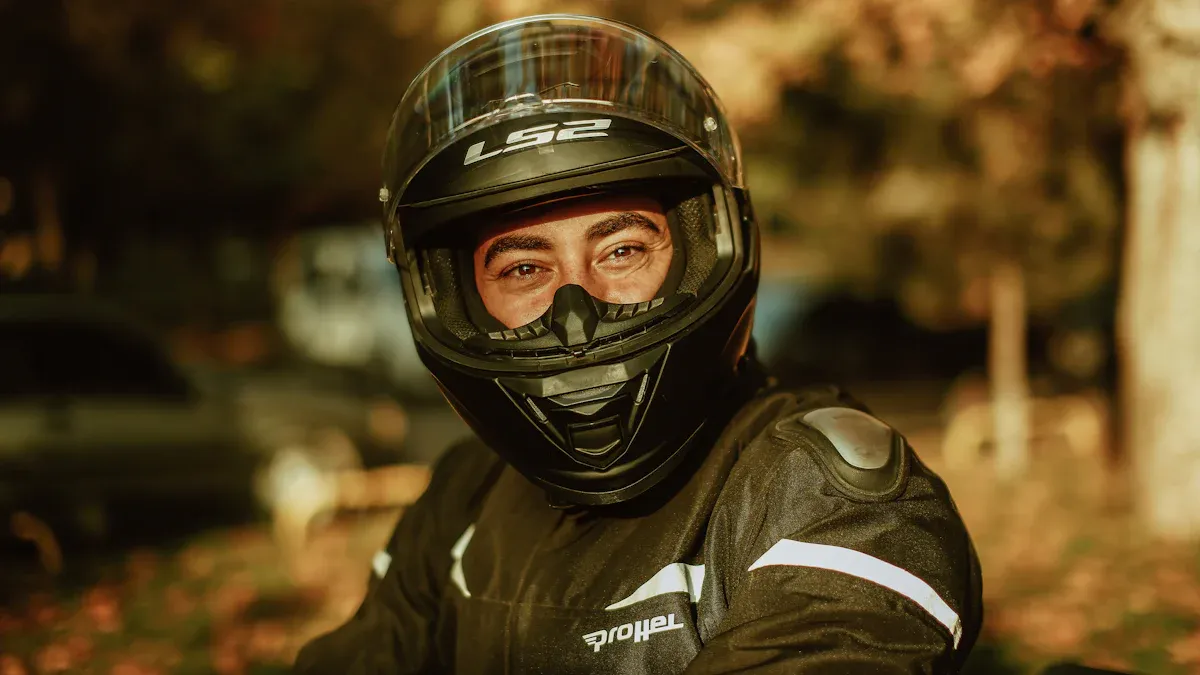
A helmet that fits you well protects your head and face in a crash. Many motorcyclists do not realize how important a proper fit is for safety. If your helmet feels loose or moves around, it cannot protect you as it should. Over one-third of riders wear helmets that do not fit right, which increases the risk of injury. You can see the risks in the table below:
| Aspect | Data / Statistic | Associated Risk |
|---|---|---|
| Percentage of cyclists with properly fitting helmets | 65.3% | N/A |
| Percentage of cyclists with improperly fitting helmets | 34.7% | N/A |
| Children’s odds of proper helmet fit | Lowest among age groups (OR=0.13) | N/A |
| Risk of head injury with poor helmet fit | Nearly 2 times higher | Nearly 2-fold increased risk of head injury |
| Risk if helmet comes off during crash | N/A | 3 times higher risk of head injury |
| Risk if helmet worn too far back | N/A | Nearly 5 times higher odds of facial injury |
Measuring for the Right Helmet Size
You need to measure your head before you buy a helmet. Follow these steps for the best fit:
- Use a soft tape measure to wrap around your head, just above your eyebrows and around the widest part at the back.
- Ask a friend to help for better accuracy.
- Compare your measurement with the helmet size chart from the manufacturer.
- Try on the helmet. It should feel snug but not painfully tight.
- Wear the helmet for 15 to 30 minutes to check for pressure points.
- Make sure the helmet does not move when you shake your head.
- Adjust with different pads or liners if needed.
- Always fasten the helmet strap to keep it secure.
Considering Head Shape and Comfort Features
Your head shape matters when you pick a helmet. Most people have a long oval, intermediate oval, or round oval head. A helmet that matches your head shape feels more comfortable and keeps you safer. Look for comfort features like soft liners, good ventilation, and removable pads. These features help you enjoy long rides and stay focused on the road.
Trying On Different Black and Gold Helmet Models
You should try on several helmet models before you choose one. Each brand fits a little differently. When you try on a black and gold motorcycle helmet, check for even pressure all around your head. The helmet should not press too hard on your forehead or sides. Wear it for at least 15 minutes to see if any spots feel sore. Motorcyclists who take time to find the right fit lower their risk of injury and ride with more confidence.
Exploring Black and Gold Motorcycle Helmet Style Options
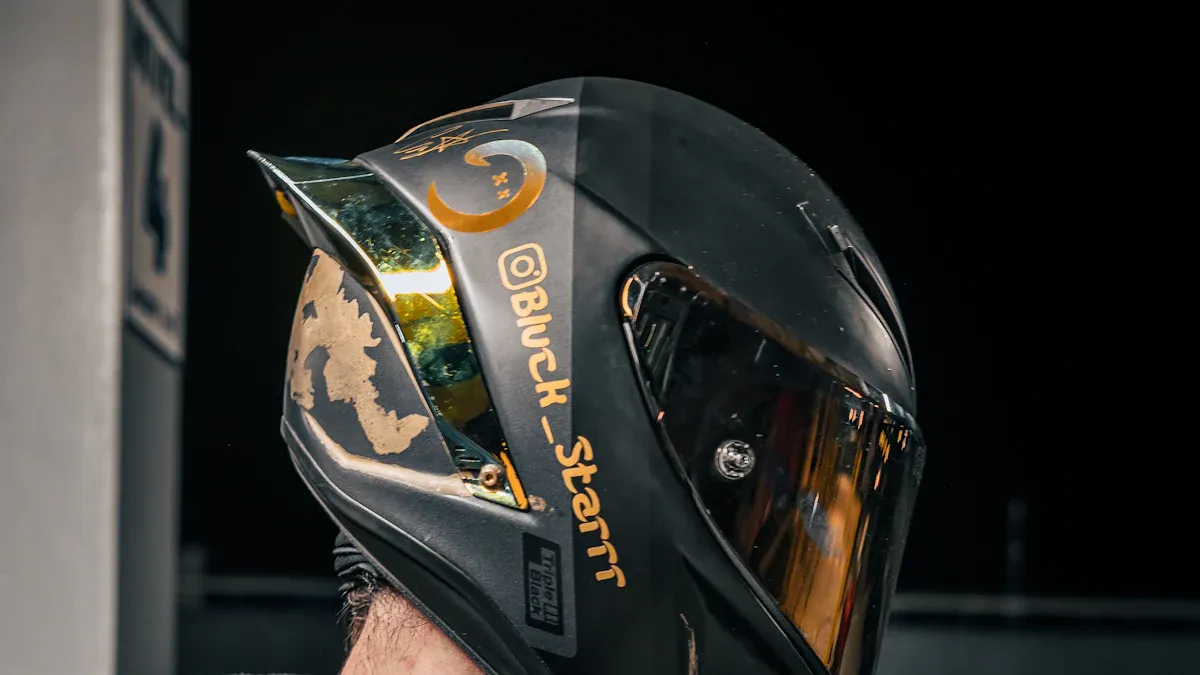
Popular Black and Gold Helmet Designs
You can find many stylish helmet designs that use black and gold colors. One popular choice is the Matte Black Gold Motorcycle Helmet from HAX Gear. This helmet stands out because it has both DOT and ECE certifications, which means it meets high safety standards. The helmet has an aerodynamic shape that helps reduce wind noise and resistance. You get extra comfort from the anti-allergic liner and dual visors, which include clear and wide lenses. The helmet also comes with a protective cloth bag for easy transport. You can choose from sizes S to XXL, and the price is $179.99. Ruroc also offers a wide range of black and gold helmets, with 27 black helmets and 6 gold helmets listed on their website. This variety lets you pick a helmet that matches your style and fits your needs.
Comparing Helmet Types: Full Face, Open Face, Supermoto, Modular
Choosing the right helmet type is important for both safety and style. Here is a table to help you compare the main types:
| Helmet Type | Safety Features | Style and Comfort Features |
|---|---|---|
| Full Face | Highest protection with a one-piece shell and strong chin bar. Required for track riding. | Lighter, quieter, and aerodynamic. Some riders find it claustrophobic. |
| Modular | Flip-up chin bar for convenience, but less structural strength. ECE certified, not SNELL. | Heavier and sometimes noisier. Often includes sun visors. Good for hot climates. |
| Open Face | Less protection than full face. Not as safe for the chin and face. | More ventilation and a less restrictive feel. |
| Supermoto | Not detailed in sources, but often used for off-road and urban riding. | Usually has a unique look and extra ventilation. |
You may also see the motorcycle half helmet in stores. This helmet covers only the top of your head. It gives you the least protection but the most open feel. Many riders like the motorcycle half helmet for short trips or hot weather, but it does not protect your face or jaw.
Balancing Style and Safety in Helmet Selection
You want your helmet to look good and keep you safe. Always check for safety certifications like DOT, Snell, or ECE. These labels show that the helmet meets strict safety rules. Make sure your helmet fits snugly and sits level on your head. A good fit helps the helmet protect you during a crash. Choose helmets made from strong materials like fiberglass, carbon fiber, or polycarbonate. These materials keep the helmet light but strong. Look for inner liners with multi-density foam, which helps absorb impacts at different speeds.
If you pick a black and gold motorcycle helmet, think about visibility. Black helmets can be hard for drivers to see, especially at night. You can add reflective panels or LED lights to help other drivers notice you. Comfort features like good ventilation and a matte or glossy finish help manage heat, which is important for black helmets. You can also customize your helmet to match your motorcycle or your riding environment. If you like the look of a motorcycle half helmet, remember that it offers less protection than other types. Always balance your style with your need for safety.
Understanding Motorcycle Helmet Safety Ratings and Certifications
Key Certifications: DOT, ECE, Snell
When you shop for a motorcycle helmet, you see different safety certifications. These labels show that the helmet meets strict rules for protection. The three most common certifications are DOT, ECE, and Snell.
The DOT certification is required for every motorcycle helmet sold in the United States. This standard checks for impact resistance, retention system strength, and field of vision. Manufacturers test their own helmets, but independent labs also check samples. DOT helmets must pass impact tests up to 400 g. However, some helmets fail in outside tests because DOT relies on self-certification.
ECE 22.06 is the main standard in Europe. This certification uses independent labs and tests helmets for energy absorption, penetration, and rotational forces. ECE helmets must pass regular updates and include tests for accessories like sun visors and Bluetooth systems.
Snell certification is voluntary but very strict. Snell tests helmets for higher impact resistance, up to 275 g, and checks chin bar strength, penetration, and emergency removal. Snell helmets go through re-certification every five years. Many racers trust Snell helmets for the best protection.
| Certification | Regulatory Status | Testing Frequency | Impact Testing Standards | Additional Tests | Certification Process | Geographic Recognition |
|---|---|---|---|---|---|---|
| DOT (FMVSS 218) | Mandatory in U.S. | Every 5 years | Max 400 g impact; flat/hemispherical anvils | Retention, chin bar, vision | Self-certification; sample testing | United States |
| ECE 22.06 | Mandatory in Europe | Regular updates | Oblique impact, energy absorption, penetration | Modular, visors, accessories | Independent labs | Europe, global |
| Snell | Voluntary | Every 5 years | Max 275 g impact; multiple anvils | Chin bar, stability, penetration, emergency removal | Independent, nonprofit | Worldwide, racing |
Tip: Always check for these certifications on your helmet. They help you know your helmet offers real protection.
What Safety Ratings Mean for Black and Gold Helmets
Safety ratings play a big role when you pick a black and gold motorcycle helmet. These ratings show that the helmet passed tough tests for impact and comfort. For example, the Matte Black Gold Motorcycle Helmet from HAX Gear meets both DOT and ECE 22.06 standards. This helmet gives you aerodynamic design, strong ventilation, and emergency padding removal. You get comfort and protection in one package.
- Safety ratings like DOT, ECE, and Snell help you compare helmets for protection.
- SHARP and FIM ratings also guide you by showing real-world test results.
- Snell helmets often weigh more and cost more, but they give extra protection for racing.
- Helmets with these certifications give you confidence in their safety and comfort.
- Black and gold helmets with DOT or ECE labels, like the HAX Gear model, show you can have style and protection together.
When you see a safety rating on a helmet, you know it meets strict rules. This helps you trust your helmet to protect you on every motorcycle ride.
Motorcycle Helmet Price Ranges and Features
How Features and Materials Affect Helmet Cost
When you shop for a motorcycle helmet, you see many prices. Some helmets cost less than $100, while others reach over $1,200. The price depends on the materials, features, and safety technology. Polycarbonate helmets are the most affordable. These helmets feel heavier and work well for low-speed impacts. Fiberglass helmets cost more and weigh less. They spread impact energy better and offer a good balance between price and protection. Carbon fiber helmets are the most expensive. You get a lightweight helmet that performs best in high-speed crashes. Racing helmets often use carbon fiber for top safety.
Here is a table to help you compare helmet materials and their effects:
| Material | Cost Level | Weight | Safety Performance |
|---|---|---|---|
| Polycarbonate | Most affordable | Heaviest | Good for low-speed impacts |
| Fiberglass | Mid-range cost | Lighter | Balances impact and flexibility |
| Carbon Fiber | Most expensive | Lightest | Best for high-speed impacts |
Advanced features also raise the price. Helmets with Bluetooth speakers, cameras, and emergency alert systems cost more. For example, the 6D ATR-3 Patriot helmet in Matte Black costs $794.95. It uses Omni-Directional Suspension™ for better energy management. Many premium helmets with advanced safety features cost between $750 and $850. You find basic helmets for as low as $91, but they may not have the same level of protection.
Balancing Budget, Safety, and Style in Black and Gold Helmets
You want a helmet that fits your budget, keeps you safe, and looks great. Start by choosing a helmet with DOT, ECE, or Snell certification. These labels show the helmet meets safety standards. Pick a material that matches your needs. Polycarbonate works for budget helmets. Fiberglass and carbon fiber offer more protection and style, but cost more.
You can find helmets with modern technology, like MIPS pads or anti-fog visors, without spending too much. The LIVALL MC1 Pro helmet shows you can get Bluetooth speakers, a camera, and an SOS alert system for $100 to $800. Look for helmets with good ventilation and comfort features. Try to avoid buying used helmets because you cannot know if they have hidden damage.
Here are some tips to help you balance budget, safety, and style:
- Choose a helmet with safety certification.
- Measure your head for the right fit.
- Look for sales or price match guarantees.
- Add accessories like custom graphics or Bluetooth speakers.
- Replace your helmet every five years or after a crash.
Note: More expensive helmets are not always safer. Focus on safety ratings and fit before style or price.
You can find a black and gold motorcycle helmet that protects you, matches your style, and fits your budget. Take your time and compare features to make the best choice.
Making Your Final Black and Gold Motorcycle Helmet Choice
Investing in Quality and Certified Helmets
You make a smart choice when you invest in a certified helmet. Certified helmets meet strict safety standards and offer better protection than non-certified or novelty helmets. Most motorcyclists in states with universal helmet laws choose certified helmets, but some still use non-certified options. The table below shows how helmet use changes based on state laws:
| Category | States with Universal Helmet Laws (2009) | States with Partial/No Helmet Laws (2009) | States with Universal Helmet Laws (2010) | States with Partial/No Helmet Laws (2010) |
|---|---|---|---|---|
| Percentage using certified helmets (FMVSS No. 218-compliant) | 86% | 55% | 76% | 40% |
| Percentage using non-certified helmets (noncompliant/novelty) | 11% | 8% | 22% | 8% |
| Percentage not wearing helmets | 3% | 37% | 2% | 52% |
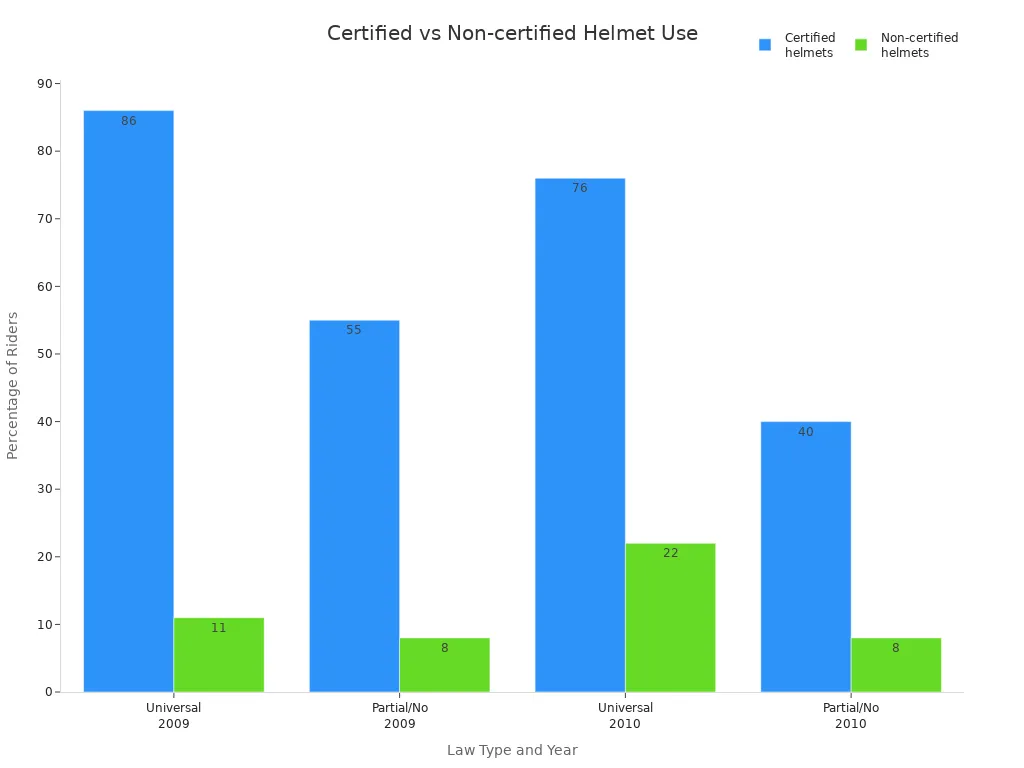
Certified, high-quality helmets use EPS foam liners to absorb impact energy. These helmets protect you in a crash but need replacement after any major impact. Some helmets use advanced features like MIPS to reduce rotational forces and lower concussion risk. You find that full-face helmets give the most coverage and protection. Modular and open-face helmets offer less coverage but may suit your riding style. When you choose a black and gold motorcycle helmet, look for DOT, ECE, or Snell certification. These labels show the helmet passed tough tests for safety and durability.
You should also consider key factors before making your final decision. The table below lists what matters most:
| Key Factor | Explanation |
|---|---|
| Helmet Types | Full-face (most protection), open-face, modular, half, off-road; choose based on riding style and protection needs. |
| Safety Certifications | DOT is minimum US standard; Snell and ECE offer higher or international standards ensuring better protection. |
| Fit | Measure head circumference; helmet should fit snugly without discomfort, move with head, and have proper cheek pad contact. |
| Materials & Construction | High-quality helmets use fiberglass, carbon fiber, or polycarbonate shells with multi-density EPS liners for impact absorption. |
| Additional Safety Features | Quick-release chin straps, padded straps, integrated sun visors, emergency cheek pad removal systems enhance safety and convenience. |
| Replacement Guidelines | Replace helmets every 3-5 years or immediately after impact; internal padding degradation affects fit and protection. Avoid second-hand helmets. |
You protect yourself best when you choose certified helmets with strong materials and advanced safety features. You also increase your personal safety by following replacement guidelines and avoiding second-hand helmets.
The Importance of Trying Before Buying
You need to try on helmets before you buy one. A helmet that fits poorly cannot protect you well. Experts compare a loose helmet to a parachute with holes. You should check the fit, adjustability, and comfort features. When you try on different models, you find the right size and shape for your head. Plush padding, good ventilation, and lightweight design make the helmet comfortable. You will wear your helmet more often if it feels good, which improves long-term safety.
- You should measure your head and compare it to the manufacturer’s size chart.
- You need to check for pressure points and make sure the helmet does not move when you shake your head.
- You should look for features like removable liners and adjustable straps.
- You must try on several models to find the best fit for your head shape.
Motorcyclists who take time to try on helmets enjoy better comfort and protection. You avoid common mistakes like buying the wrong size or ignoring helmet shape compatibility. You also reduce the risk of discomfort and increase your willingness to wear the helmet every ride.
Always Prioritizing Motorcycle Safety
You must always put safety first when choosing a helmet. You can follow these steps to make sure you stay protected:
- Check for safety certifications like DOT, ECE, or Snell.
- Pick the helmet type that matches your riding style. Full-face helmets give the most protection. Modular helmets offer versatility. Open-face and half helmets provide more airflow but less coverage.
- Measure your head and try on different sizes. Make sure the helmet fits snugly and does not shift.
- Look for advanced safety technologies like MIPS to reduce rotational impact forces.
- Choose helmets with good ventilation to stay cool and focused.
- Select visor options that improve visibility and eye protection.
- Clean your helmet regularly and replace it every 3-5 years or after any crash.
- Store your helmet in a safe place to avoid damage.
You avoid mistakes by not prioritizing style over practicality. You should never buy a helmet just because it looks good. You need to think about your riding style, helmet shape, and comfort features. You also protect yourself by cleaning your helmet and replacing it on time.
Motorcyclists who focus on safety enjoy more confidence and better protection on every ride. You make a smart choice when you select a black and gold motorcycle helmet that meets safety standards, fits well, and matches your style. You show your personality while keeping your personal safety as your top priority.
You should choose a black and gold motorcycle helmet that fits well, meets safety standards, and matches your style. Certified helmets with a snug fit lower your risk of serious head injuries. Full-face helmets reduce severe injury odds by 79% and minor injury odds by 41%. Poorly fitted or unsecured helmets can come off in a crash, increasing danger.
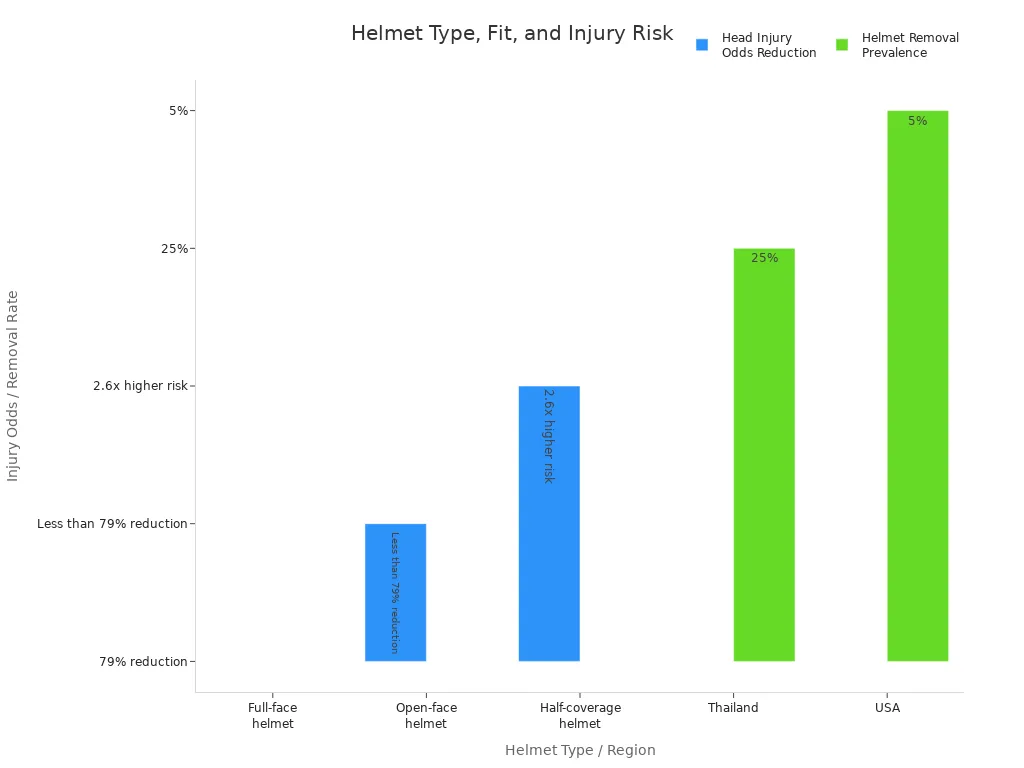
When you invest in a high-quality, certified helmet, you gain long-term protection, comfort, and durability. Always try on helmets before buying to ensure a secure, comfortable fit. Remember, safety comes first—helmets save lives and prevent brain injuries, so never compromise protection for style.
FAQ
How do you know if your black and gold helmet fits correctly?
You should feel even pressure around your head. The helmet should not move when you shake your head. Your cheeks must touch the pads. You should not feel pain or loose spots.
What safety certifications should you look for in a motorcycle helmet?
You need to check for DOT, ECE, or Snell labels. These certifications show your helmet meets strict safety standards. You can find the label inside or on the back of the helmet.
How often should you replace your motorcycle helmet?
You should replace your helmet every five years. You must get a new one after any crash or hard drop. Old helmets lose protection as materials break down.
Can you add custom graphics or stickers to your helmet?
You can add stickers or graphics if they do not cover safety labels. Use only safe adhesives. Avoid blocking vents or covering cracks. Custom designs let you show your style.
What is the best way to clean and care for your helmet?
You should use mild soap and water for cleaning. Remove pads and liners if possible. Let everything air dry. Store your helmet in a cool, dry place. Avoid harsh chemicals.
See Also
Top Motorcycle Fairing Designs Every Rider Should Explore
Key Advice To Construct The Motorcycle Of Your Dreams
Important Safety Guidelines For Your Very First Motorcycle Trip
A New Rider's Handbook To Maintaining Their First Bike
Best Safety Practices For Fairing-Equipped Motorcycle Riders
